Bangers and Mash, a true British classic, is more than just a meal; it’s a comforting hug on a plate. Imagine sinking your fork into a pile of creamy, buttery mashed potatoes, perfectly complementing the savory, juicy sausages nestled on top. Is your mouth watering yet? This isn’t just dinner; it’s an experience!
The history of Bangers and Mash is as rich and flavorful as the dish itself. Originating in a time of rationing and resourcefulness, this humble meal became a staple in British households. The term “bangers” is believed to have come about during World War I, when sausages, due to meat shortages, often contained a high water content, causing them to explode or “bang” during cooking. Despite its somewhat explosive origins, this dish has stood the test of time, evolving into a beloved comfort food enjoyed worldwide.
But what is it about Bangers and Mash that makes it so universally appealing? Perhaps it’s the simplicity of the ingredients, the ease of preparation, or the sheer satisfaction of the contrasting textures and flavors. The creamy, smooth potatoes provide a comforting base, while the savory sausages offer a burst of meaty goodness. It’s a dish that’s both hearty and satisfying, perfect for a chilly evening or a quick and easy weeknight meal. Plus, it’s endlessly customizable! From adding caramelized onions and rich gravy to experimenting with different sausage varieties, the possibilities are endless. So, are you ready to discover (or rediscover) the magic of Bangers and Mash?
Ingredients:
- For the Bangers:
- 1 lb high-quality pork sausages (Bangers), preferably with a high meat content
- 1 tbsp olive oil or vegetable oil
- 1 medium onion, thinly sliced
- 1 clove garlic, minced (optional)
- 1/4 cup beef broth or chicken broth (optional, for deglazing)
- For the Mash:
- 2 lbs potatoes, preferably Yukon Gold or Maris Piper, peeled and quartered
- 1/2 cup milk (whole milk or cream for extra richness)
- 4 tbsp butter (unsalted), plus extra for serving
- Salt and freshly ground black pepper to taste
- Pinch of nutmeg (optional)
- For the Onion Gravy (Optional but Highly Recommended):
- 2 tbsp butter
- 2 large onions, thinly sliced
- 1 tbsp all-purpose flour
- 2 cups beef broth
- 1 tbsp Worcestershire sauce
- 1 tsp brown sugar (optional, for sweetness)
- Salt and freshly ground black pepper to taste
- 1 tbsp balsamic vinegar (optional, for acidity)
- Garnish (Optional):
- Fresh parsley, chopped
- Crispy fried onions
Preparing the Mash:
- Boil the Potatoes: Place the peeled and quartered potatoes in a large pot. Cover them with cold water and add a generous pinch of salt. Bring the water to a boil over high heat, then reduce the heat to medium and simmer for 15-20 minutes, or until the potatoes are fork-tender. You should be able to easily pierce them with a fork without resistance.
- Drain the Potatoes: Once the potatoes are cooked, carefully drain them in a colander. Return the potatoes to the empty pot.
- Dry the Potatoes (Important!): Place the pot back on the stovetop over low heat for about a minute or two. This will help to evaporate any excess moisture from the potatoes, resulting in a fluffier mash. Keep an eye on them to prevent burning.
- Mash the Potatoes: Remove the pot from the heat. Add the butter and milk (or cream) to the potatoes. Using a potato masher or a ricer, mash the potatoes until they are smooth and creamy. Be careful not to over-mash, as this can make them gluey. If using a ricer, pass the potatoes through the ricer back into the pot.
- Season the Mash: Season the mashed potatoes with salt and freshly ground black pepper to taste. Add a pinch of nutmeg if desired. Stir well to combine. Taste and adjust the seasoning as needed. Keep the mashed potatoes warm until ready to serve. You can cover the pot with a lid or place it in a warm oven (around 200°F or 95°C) to keep them warm.
Cooking the Bangers:
- Prepare the Sausages: Prick the sausages a few times with a fork. This will help to prevent them from bursting during cooking.
- Brown the Sausages: Heat the olive oil or vegetable oil in a large skillet over medium heat. Add the sausages to the skillet and cook, turning occasionally, until they are browned on all sides and cooked through. This usually takes about 15-20 minutes, depending on the thickness of the sausages. Make sure the internal temperature reaches 160°F (71°C).
- Cook the Onions (Optional): Remove the sausages from the skillet and set them aside on a plate. Add the sliced onion to the skillet and cook over medium heat, stirring occasionally, until they are softened and lightly caramelized, about 8-10 minutes. If using garlic, add it to the skillet during the last minute of cooking.
- Deglaze the Pan (Optional): If desired, deglaze the pan with beef broth or chicken broth. Pour the broth into the skillet and scrape up any browned bits from the bottom of the pan. Bring the broth to a simmer and cook for a few minutes, until it has slightly reduced.
- Return Sausages to Pan: Return the cooked sausages to the skillet with the onions (and deglazing liquid, if used). Heat through for a minute or two.
Making the Onion Gravy:
- Caramelize the Onions: Melt the butter in a large saucepan or skillet over medium-low heat. Add the sliced onions and cook, stirring occasionally, until they are deeply caramelized and golden brown. This process takes time, usually about 30-45 minutes. Be patient and stir frequently to prevent the onions from burning. The key to good onion gravy is well-caramelized onions.
- Add Flour: Once the onions are caramelized, sprinkle the flour over them. Cook, stirring constantly, for 1-2 minutes to create a roux. This will help to thicken the gravy.
- Add Broth: Gradually whisk in the beef broth, making sure to break up any lumps of flour. Bring the mixture to a simmer, stirring constantly.
- Season and Simmer: Add the Worcestershire sauce, brown sugar (if using), salt, and freshly ground black pepper to taste. Reduce the heat to low and simmer for 15-20 minutes, or until the gravy has thickened to your desired consistency. Stir occasionally to prevent sticking.
- Adjust Flavor (Optional): If desired, add a tablespoon of balsamic vinegar during the last few minutes of cooking for a touch of acidity. Taste and adjust the seasoning as needed.
Assembling the Dish:
- Plate the Mash: Spoon a generous portion of mashed potatoes onto each plate.
- Add the Bangers: Place the cooked bangers on top of the mashed potatoes.
- Drizzle with Gravy: Ladle the onion gravy generously over the bangers and mash.
- Garnish (Optional): Garnish with fresh parsley, chopped, and/or crispy fried onions, if desired.
- Serve Immediately: Serve immediately and enjoy!
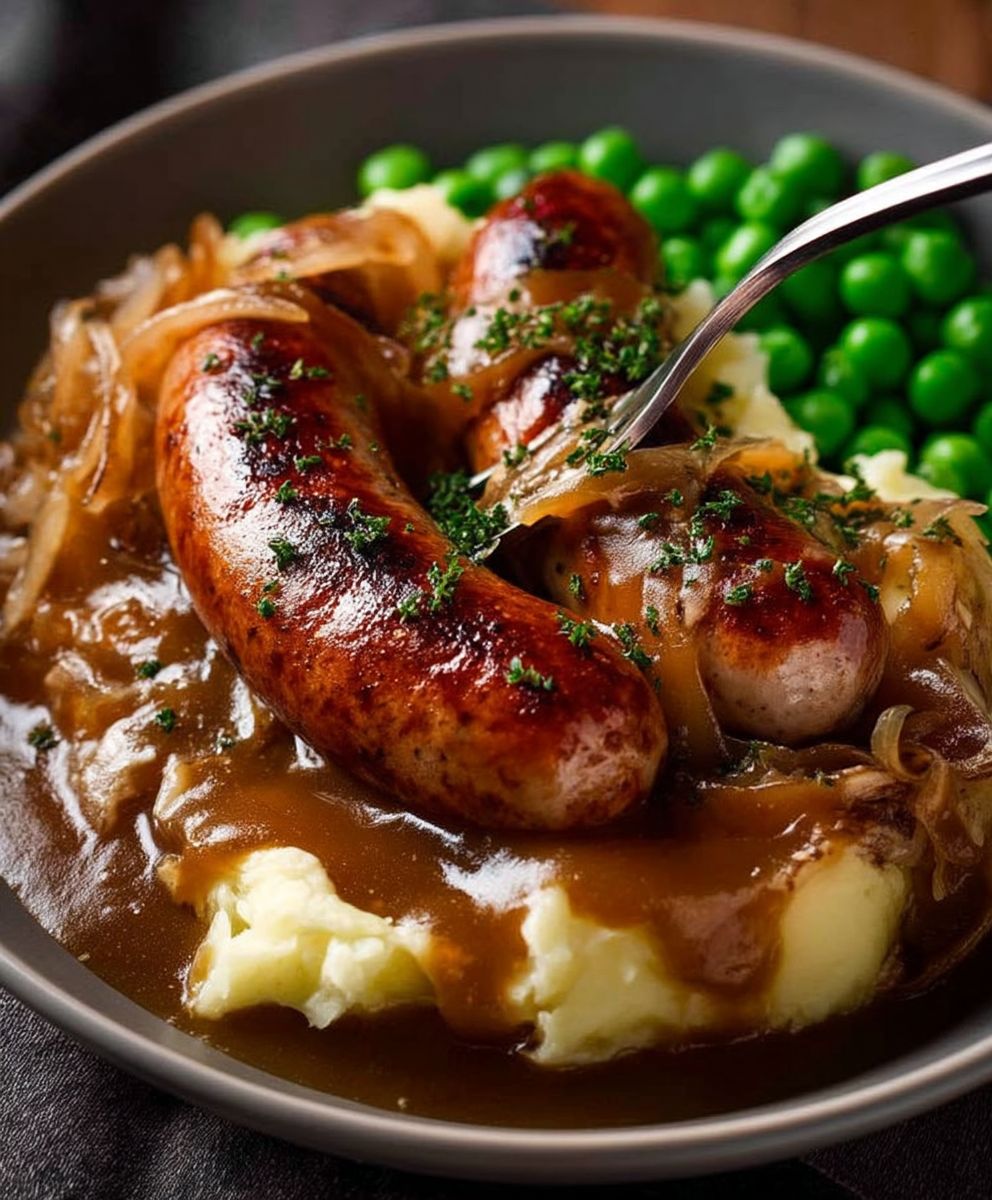
Conclusion:
So there you have it! This isn’t just any recipe; it’s a hearty, comforting plate of Bangers and Mash that’s guaranteed to warm you from the inside out. From the perfectly browned sausages to the creamy, dreamy mashed potatoes, and that rich, savory onion gravy, every element works in perfect harmony. It’s a classic for a reason, and I truly believe this version elevates it to something truly special.
Why is this a must-try? Well, beyond the sheer deliciousness, it’s incredibly satisfying and relatively simple to make. It’s the kind of meal that brings people together, perfect for a cozy weeknight dinner or a casual weekend gathering. Plus, it’s a fantastic way to use up any leftover potatoes you might have lurking in your pantry. But more than that, it’s about experiencing a taste of tradition, a culinary hug that reminds you of simpler times.
Now, let’s talk serving suggestions and variations because the possibilities are endless! For a truly authentic experience, serve your Bangers and Mash with a generous dollop of English mustard or a spoonful of tangy Branston pickle. A side of buttered peas or green beans adds a touch of freshness and balances the richness of the dish.
Feeling adventurous? Why not try adding a splash of Guinness to your onion gravy for a deeper, more complex flavor? Or, for a vegetarian twist, swap out the pork sausages for vegetarian sausages there are some fantastic options available these days that are just as flavorful. You could even experiment with different types of potatoes for your mash. Russets will give you a light and fluffy texture, while Yukon Golds will result in a creamier, more buttery mash. Adding roasted garlic to the mash is another great way to elevate the flavor profile.
And don’t forget about the sausages themselves! While traditional pork bangers are the classic choice, feel free to experiment with different varieties. Cumberland sausages, with their distinctive peppery flavor, would be a delicious alternative. Or, if you’re feeling particularly fancy, try using gourmet sausages with interesting flavor combinations like apple and sage or chorizo and chili.
The key to truly great Bangers and Mash is in the details. Don’t skimp on the quality of your ingredients, and take your time with each step. Browning the sausages properly is crucial for developing that rich, savory flavor. And remember to season your mashed potatoes generously a little salt and pepper goes a long way.
But most importantly, have fun with it! Cooking should be an enjoyable experience, so don’t be afraid to experiment and put your own personal touch on this classic dish. I’m confident that once you try this recipe, it will become a regular in your rotation.
So, what are you waiting for? Grab your ingredients, put on some music, and get cooking! I’m absolutely certain you’ll love this recipe as much as I do. And when you do, please, please, please come back and share your experience in the comments below. I’d love to hear what you think, what variations you tried, and any tips or tricks you discovered along the way. Your feedback is invaluable, and it helps me to continue creating recipes that you’ll love. I can’t wait to hear all about your Bangers and Mash adventures! Happy cooking!
Bangers and Mash: The Ultimate Guide to This Classic Dish
Classic Bangers and Mash with rich onion gravy a comforting British pub favorite!
Ingredients
- 1 lb high-quality pork sausages (Bangers), preferably with a high meat content
- 1 tbsp olive oil or vegetable oil
- 1 medium onion, thinly sliced
- 1 clove garlic, minced (optional)
- 1/4 cup beef broth or chicken broth (optional, for deglazing)
- 2 lbs potatoes, preferably Yukon Gold or Maris Piper, peeled and quartered
- 1/2 cup milk (whole milk or cream for extra richness)
- 4 tbsp butter (unsalted), plus extra for serving
- Salt and freshly ground black pepper to taste
- Pinch of nutmeg (optional)
- 2 tbsp butter
- 2 large onions, thinly sliced
- 1 tbsp all-purpose flour
- 2 cups beef broth
- 1 tbsp Worcestershire sauce
- 1 tsp brown sugar (optional, for sweetness)
- Salt and freshly ground black pepper to taste
- 1 tbsp balsamic vinegar (optional, for acidity)
- Fresh parsley, chopped
- Crispy fried onions
Instructions
- Place the peeled and quartered potatoes in a large pot. Cover them with cold water and add a generous pinch of salt. Bring the water to a boil over high heat, then reduce the heat to medium and simmer for 15-20 minutes, or until the potatoes are fork-tender. You should be able to easily pierce them with a fork without resistance.
- Once the potatoes are cooked, carefully drain them in a colander. Return the potatoes to the empty pot.
- Place the pot back on the stovetop over low heat for about a minute or two. This will help to evaporate any excess moisture from the potatoes, resulting in a fluffier mash. Keep an eye on them to prevent burning.
- Remove the pot from the heat. Add the butter and milk (or cream) to the potatoes. Using a potato masher or a ricer, mash the potatoes until they are smooth and creamy. Be careful not to over-mash, as this can make them gluey. If using a ricer, pass the potatoes through the ricer back into the pot.
- Season the mashed potatoes with salt and freshly ground black pepper to taste. Add a pinch of nutmeg if desired. Stir well to combine. Taste and adjust the seasoning as needed. Keep the mashed potatoes warm until ready to serve. You can cover the pot with a lid or place it in a warm oven (around 200°F or 95°C) to keep them warm.
- Prick the sausages a few times with a fork. This will help to prevent them from bursting during cooking.
- Heat the olive oil or vegetable oil in a large skillet over medium heat. Add the sausages to the skillet and cook, turning occasionally, until they are browned on all sides and cooked through. This usually takes about 15-20 minutes, depending on the thickness of the sausages. Make sure the internal temperature reaches 160°F (71°C).
- Remove the sausages from the skillet and set them aside on a plate. Add the sliced onion to the skillet and cook over medium heat, stirring occasionally, until they are softened and lightly caramelized, about 8-10 minutes. If using garlic, add it to the skillet during the last minute of cooking.
- If desired, deglaze the pan with beef broth or chicken broth. Pour the broth into the skillet and scrape up any browned bits from the bottom of the pan. Bring the broth to a simmer and cook for a few minutes, until it has slightly reduced.
- Return the cooked sausages to the skillet with the onions (and deglazing liquid, if used). Heat through for a minute or two.
- Melt the butter in a large saucepan or skillet over medium-low heat. Add the sliced onions and cook, stirring occasionally, until they are deeply caramelized and golden brown. This process takes time, usually about 30-45 minutes. Be patient and stir frequently to prevent the onions from burning. The key to good onion gravy is well-caramelized onions.
- Once the onions are caramelized, sprinkle the flour over them. Cook, stirring constantly, for 1-2 minutes to create a roux. This will help to thicken the gravy.
- Gradually whisk in the beef broth, making sure to break up any lumps of flour. Bring the mixture to a simmer, stirring constantly.
- Add the Worcestershire sauce, brown sugar (if using), salt, and freshly ground black pepper to taste. Reduce the heat to low and simmer for 15-20 minutes, or until the gravy has thickened to your desired consistency. Stir occasionally to prevent sticking.
- If desired, add a tablespoon of balsamic vinegar during the last few minutes of cooking for a touch of acidity. Taste and adjust the seasoning as needed.
- Spoon a generous portion of mashed potatoes onto each plate.
- Place the cooked bangers on top of the mashed potatoes.
- Ladle the onion gravy generously over the bangers and mash.
- Garnish with fresh parsley, chopped, and/or crispy fried onions, if desired.
- Serve immediately and enjoy!
Notes
- The onion gravy is optional but highly recommended for the full Bangers and Mash experience.
- For extra rich mashed potatoes, use cream instead of milk.
- Be patient when caramelizing the onions for the gravy. The longer they cook, the sweeter and more flavorful the gravy will be.
- Adjust seasoning to your preference.

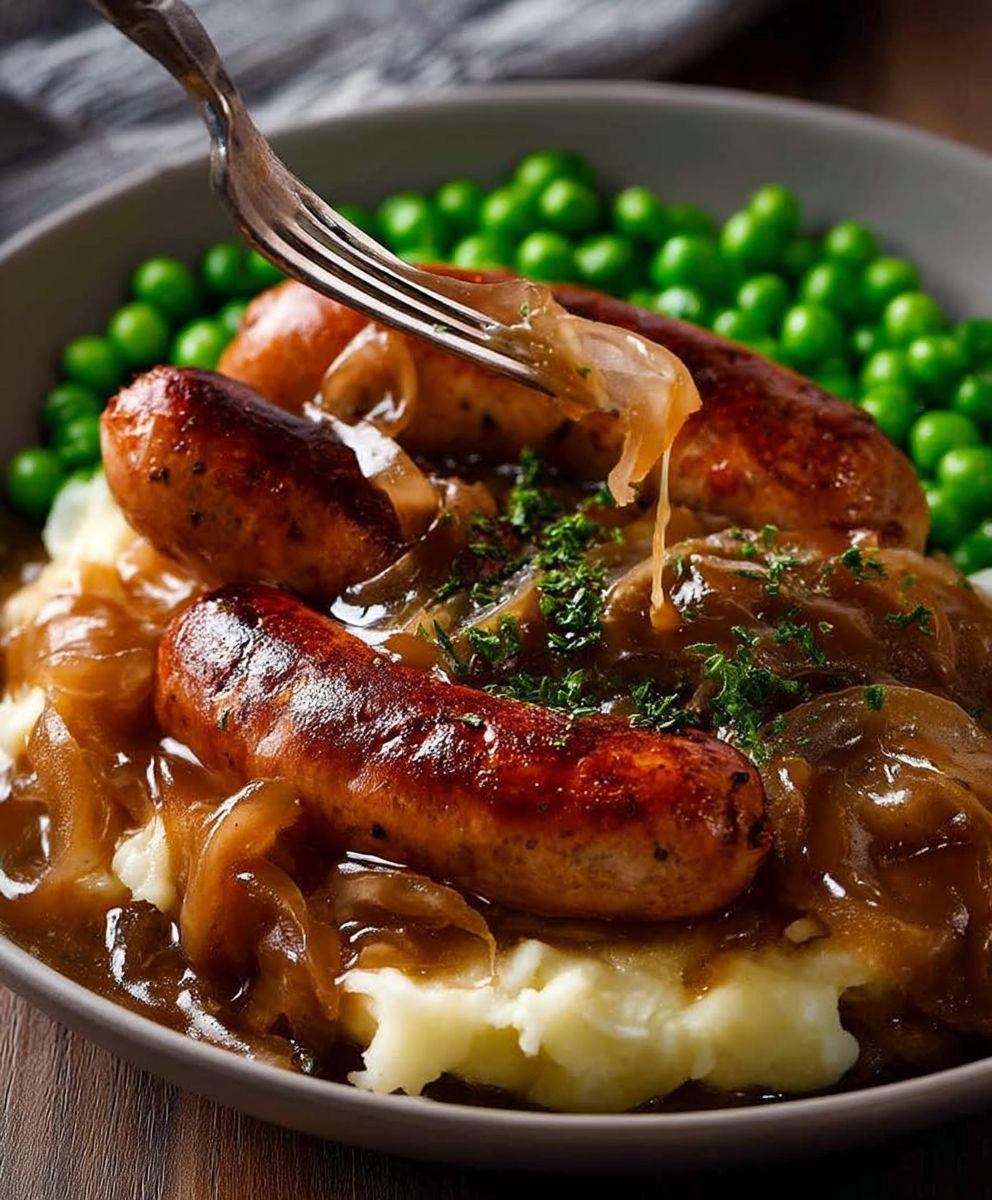
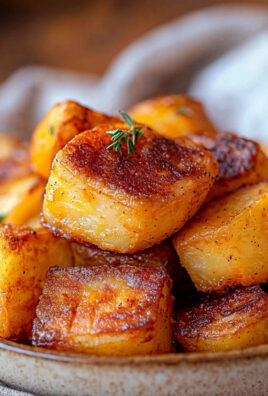
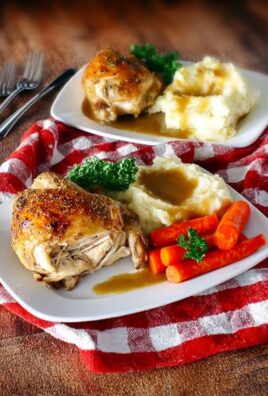
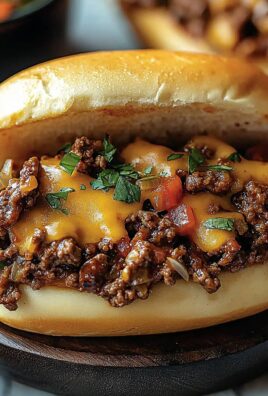
Leave a Comment